 In this installment, we’ll give you the steps for replacing the transmission fluid and fluid filter inside your vehicle’s automatic transmission – saving you several hundred dollars by sparing you a visit to the shop. This maintenance procedure is a straightforward one, and it’s important for the overall longevity of your transmission. The engineers that built your car tested it thoroughly, and they know more than anyone on earth does about its breaking points and how to keep mechanical components healthy, so following your vehicle manufacturer’s recommended service intervals is essential. While draining a trans pan and refilling it only replaces one-half to two-thirds of your overall fluid (the rest remains inside the torque converter), don’t let it diminish the importance of keeping your automatic trans fluid (ATF) fresh.
In this installment, we’ll give you the steps for replacing the transmission fluid and fluid filter inside your vehicle’s automatic transmission – saving you several hundred dollars by sparing you a visit to the shop. This maintenance procedure is a straightforward one, and it’s important for the overall longevity of your transmission. The engineers that built your car tested it thoroughly, and they know more than anyone on earth does about its breaking points and how to keep mechanical components healthy, so following your vehicle manufacturer’s recommended service intervals is essential. While draining a trans pan and refilling it only replaces one-half to two-thirds of your overall fluid (the rest remains inside the torque converter), don’t let it diminish the importance of keeping your automatic trans fluid (ATF) fresh.
PARTS, SUPPLIES, AND TOOLS NEEDED:
-Open-ended wrench or socket wrench for removing transmission pan bolts
-Vehicle jack or ramps (if extra clearance room will be needed)
-Wheeled creeper (for comfort)
-Stong grease remover for removal of caked-on old gasket material
-Scraping blade or putty knife for removal of old gasket material
-Gasket sealer to aid in sealing your new gasket
-Torque wrench for applying the correct amount of torque when tightening pan bolts back in
-Automatic transmission fluid for standard driving or racing-oriented applications
-Transmission gasket and filter kit
-Wheel chocks for placing behind rear wheels to keep vehicle from shifting or rolling back
-Large diameter drain pan for pouring old fluid into
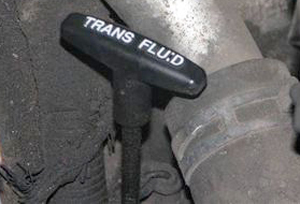 For the purposes of this article, we only recommend the procedure for vehicles that are designed for regular fluid changes – not cars or trucks with sealed transmission pans and lifetime transmission fluid. Such vehicles require special machines to drain and fill the transmission case, and the fluid itself often needs to be heated to certain temperatures before installation. If you’re not sure whether your automatic transmission is maintenance-free or requires maintenance, a quick check of the owner’s manual will provide that information. If you can find a traditional-looking trans fluid dipstick underhood that pulls out normally, chances are your vehicle was designed for regular transmission fluid changes.
For the purposes of this article, we only recommend the procedure for vehicles that are designed for regular fluid changes – not cars or trucks with sealed transmission pans and lifetime transmission fluid. Such vehicles require special machines to drain and fill the transmission case, and the fluid itself often needs to be heated to certain temperatures before installation. If you’re not sure whether your automatic transmission is maintenance-free or requires maintenance, a quick check of the owner’s manual will provide that information. If you can find a traditional-looking trans fluid dipstick underhood that pulls out normally, chances are your vehicle was designed for regular transmission fluid changes.
While transmission fluid is not subject to the grueling conditions of combustion and carbon buildup that motor oil is, metal particles do wear off bearings, gears, and friction plates under normal use because those components are under constant motion inside the transmission. While all automatics have a filter that traps metal flakes and debris, some manufacturers design filters that only catch larger debris and allow more metal to travel unstrained around transmission internals – causing cumulative wear as it builds up and circulates. So it’s important to get contaminants out with a new filter and fluid.
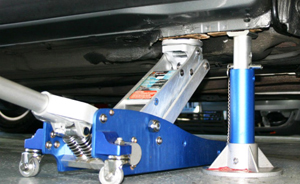 1) After confirming the presence and location of your transmission fluid dipstick, drive the vehicle up on ramps. Or, jack each side of the vehicle up and insert a jack stand to support its weight. Make sure the gear selector is in park, the emergency brake is on, and wheel chocks are located behind rear wheels to ensure the vehicle stays still.
1) After confirming the presence and location of your transmission fluid dipstick, drive the vehicle up on ramps. Or, jack each side of the vehicle up and insert a jack stand to support its weight. Make sure the gear selector is in park, the emergency brake is on, and wheel chocks are located behind rear wheels to ensure the vehicle stays still.
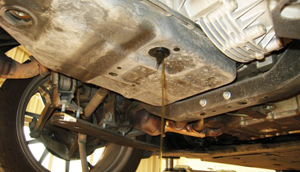 2) Place as large a drain pan as you can find underneath the transmission itself because when you first lower the pan, fluid will spill out from every side. Locate the drain plug on the transmission pan (if so equipped) and remove it using a wrench. Let as much fluid drain out this way as possible. If the transmission pan on your vehicle has no drain plug, proceed directly to Step 3.
2) Place as large a drain pan as you can find underneath the transmission itself because when you first lower the pan, fluid will spill out from every side. Locate the drain plug on the transmission pan (if so equipped) and remove it using a wrench. Let as much fluid drain out this way as possible. If the transmission pan on your vehicle has no drain plug, proceed directly to Step 3.
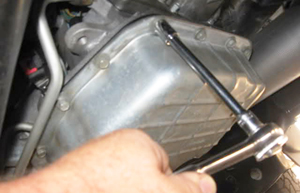 3) Using an applicable open-ended or socket wrench, start loosening the bolts on one side of the transmission pan that hold it in place. If the pan doesn’t start dropping down with the bolts, use your scraper to gently pry the old gasket loose that may be causing it to stick in place (don’t worry about tearing the old gasket because you’ll be replacing it with a new one). Leaving two or three bolts in place on one side allows the pan to “hinge down” slightly so that fluid begins to drain.
3) Using an applicable open-ended or socket wrench, start loosening the bolts on one side of the transmission pan that hold it in place. If the pan doesn’t start dropping down with the bolts, use your scraper to gently pry the old gasket loose that may be causing it to stick in place (don’t worry about tearing the old gasket because you’ll be replacing it with a new one). Leaving two or three bolts in place on one side allows the pan to “hinge down” slightly so that fluid begins to drain.
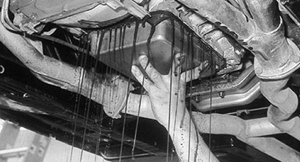 4) Remove all the bolts holding the pan in place and drop it down slowly, pouring the old fluid out into your drain pan on the ground. As you clean the remaining gunk out of the pan by hand, check the fluid itself. The fluid should be pinkish, but if it’s brown and smells noticeably burned your transmission may have other issues that should be checked by a professional – especially if you notice erratic shifting or slippage. It’s normal to see some amount of metal flakes in the old fluid and at the bottom of the pan, so don’t worry if you do.
4) Remove all the bolts holding the pan in place and drop it down slowly, pouring the old fluid out into your drain pan on the ground. As you clean the remaining gunk out of the pan by hand, check the fluid itself. The fluid should be pinkish, but if it’s brown and smells noticeably burned your transmission may have other issues that should be checked by a professional – especially if you notice erratic shifting or slippage. It’s normal to see some amount of metal flakes in the old fluid and at the bottom of the pan, so don’t worry if you do.
Magnetic Drain Plugs
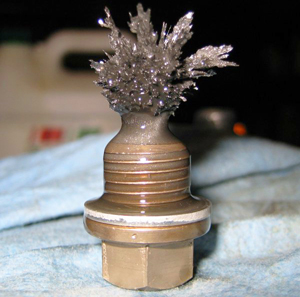 Magnetic transmission pan drain plugs are a great investment for pennies on the dollar. They attract and cling onto all small metal flakes which circulate in the fluid that the filter may not catch – effectively removing them from your moving transmission parts. When removed during a routine transmission fluid and filter change, you’ll notice a great deal of particles clinging to the plug. Simply wipe them off, clean the plug, and reinstall.
Magnetic transmission pan drain plugs are a great investment for pennies on the dollar. They attract and cling onto all small metal flakes which circulate in the fluid that the filter may not catch – effectively removing them from your moving transmission parts. When removed during a routine transmission fluid and filter change, you’ll notice a great deal of particles clinging to the plug. Simply wipe them off, clean the plug, and reinstall.
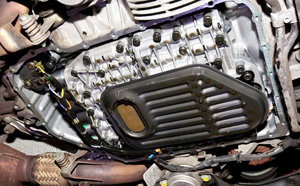 5) Remove your old transmission filter, which will typically be screwed or bolted onto the underside of transmission internals. As you install the new one, use caution not to overtighten anything. Your owner’s manual should supply exact specifications of how tightly your bolts should be torqued. If it doesn’t, check the internet for online repair instructions on your make and model or place a call to the vehicle manufacturer directly. A torque wrench which clicks at a pre-set torque amount is an excellent, helpful tool for getting precisely the right amount of tightness, so use on if you have it. Over-torqueing screws or nuts here can cause metal to warp and compromise the functionality of your filter.
5) Remove your old transmission filter, which will typically be screwed or bolted onto the underside of transmission internals. As you install the new one, use caution not to overtighten anything. Your owner’s manual should supply exact specifications of how tightly your bolts should be torqued. If it doesn’t, check the internet for online repair instructions on your make and model or place a call to the vehicle manufacturer directly. A torque wrench which clicks at a pre-set torque amount is an excellent, helpful tool for getting precisely the right amount of tightness, so use on if you have it. Over-torqueing screws or nuts here can cause metal to warp and compromise the functionality of your filter.
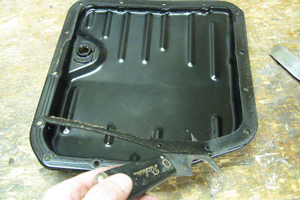 6) Use your scraper to remove parts of the old gasket that are clinging to the pan edges and to the transmission. Strong grease removers and cleaners will make removal of the most stubborn gasket material easy, and it’s important to clean all surfaces flush down to the metal.
6) Use your scraper to remove parts of the old gasket that are clinging to the pan edges and to the transmission. Strong grease removers and cleaners will make removal of the most stubborn gasket material easy, and it’s important to clean all surfaces flush down to the metal.
7) Install the new transmission gasket on the pan and use sealer as needed to create a thorough bond.
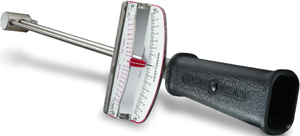 8) Mount the transmission pan back onto the transmission housing and tighten the bolts. As with filter installation, it’s strongly recommended to use a torque wrench to prevent over-tightening of the bolts and warping of the pan. Aluminum trans pans are very susceptible to warpage when bolts are overtightened, and large fluid leaks usually always result.
8) Mount the transmission pan back onto the transmission housing and tighten the bolts. As with filter installation, it’s strongly recommended to use a torque wrench to prevent over-tightening of the bolts and warping of the pan. Aluminum trans pans are very susceptible to warpage when bolts are overtightened, and large fluid leaks usually always result.
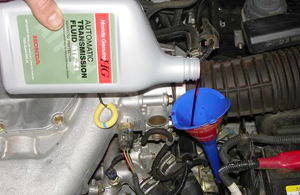 9) With the engine off, pour several quarts of transmission fluid into your dipstick using a clean funnel with a long neck tube. There are a wide variety of blends when it comes to automatic transmission fluid and it’s important to use exactly what’s specified by your vehicle manufacturer. If you don’t have an owner’s manual to check, contact the manufacturer themselves.
9) With the engine off, pour several quarts of transmission fluid into your dipstick using a clean funnel with a long neck tube. There are a wide variety of blends when it comes to automatic transmission fluid and it’s important to use exactly what’s specified by your vehicle manufacturer. If you don’t have an owner’s manual to check, contact the manufacturer themselves.
After adding two to three quarts, start the engine and check the trans fluid level with it idling. Continue to add as needed until the full level is reached. Any future checks of your automatic transmission fluid level should always be done with the engine idling.

































